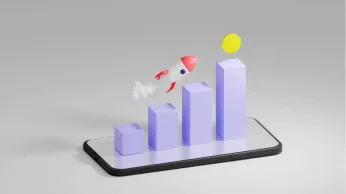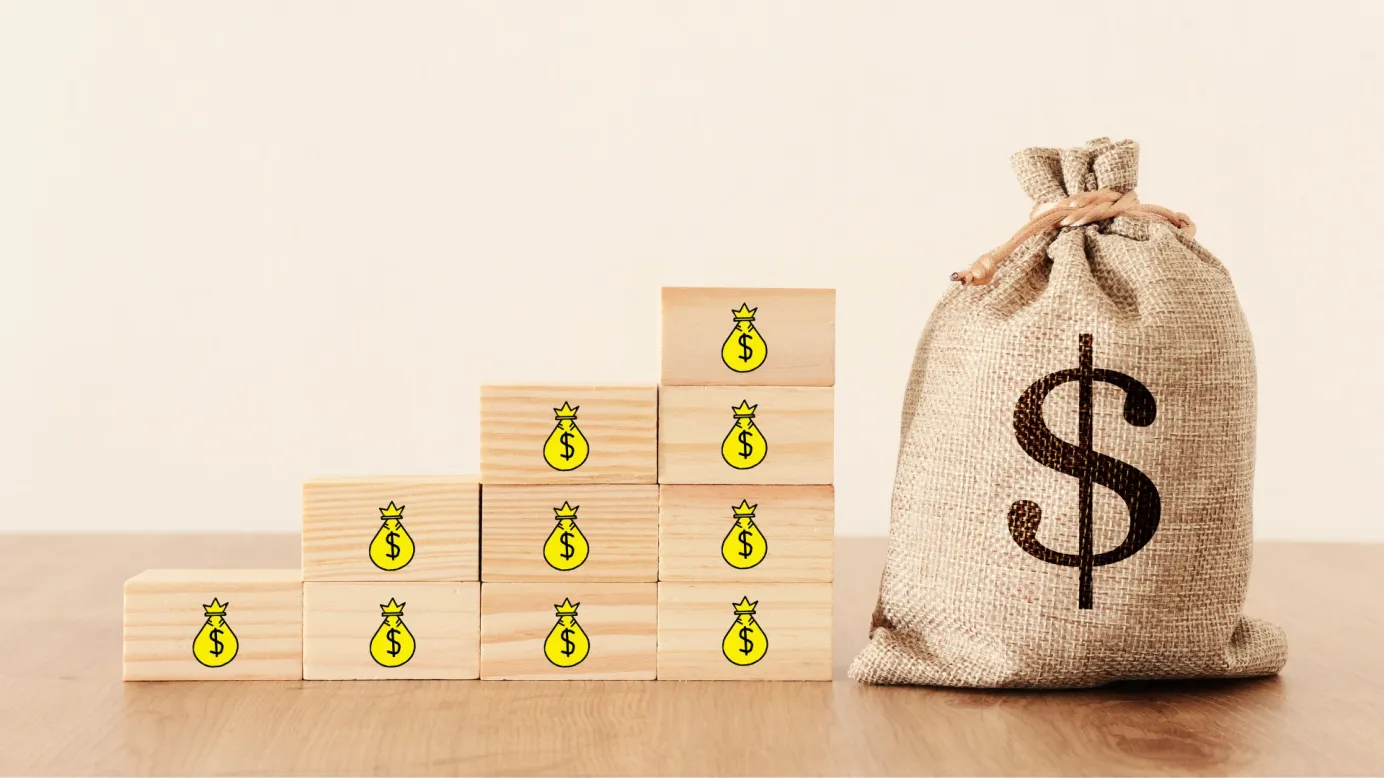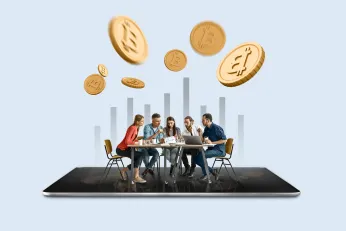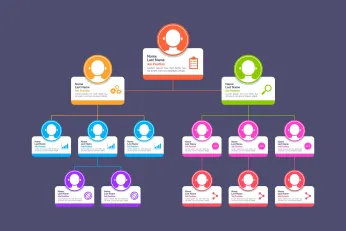كيفية إنشاء برنامج حوافز المبيعات: دليل شامل
كيف تنشئ برنامج حوافز مبيعات يحفز حقاً؟ يتعلق الأمر بأكثر من مجرد مكافآت. إن خطة الحوافز جيدة التنظيم تحفز الأداء، وتحافظ على مشاركة الفرق، وتوائم المكافآت مع أهداف العمل. يغطي هذا الدليل الخطوات الأساسية لتصميم برنامج يحقق نتائج حقيقية
في هذه الصفحة
تبحث الشركات باستمرار عن طرق لزيادة المبيعات وتحفيز فرق المبيعات لديها. وتتمثل إحدى الاستراتيجيات الفعالة في تنفيذ برنامج حوافز مبيعات جيد التصميم.
برامج حوافز المبيعات تُعد برامج حوافز المبيعات ضرورية للمؤسسات التي تتطلع إلى تحفيز فرق المبيعات لديها، وتحفيز الأداء، وتحقيق أهداف العمل. تم تصميم هذه البرامج لتوفير الحوافز والمكافآت لمحترفي المبيعات بناءً على أدائهم، مما يؤدي في النهاية إلى زيادة المبيعات والإيرادات.
يمكن لبرنامج حوافز المبيعات زيادة المبيعات وتعزيز مشاركة الموظفين وإنتاجيتهم من خلال توفير مكافآت ملموسة وتقدير للأداء المتميز.
وفقًا لدراسة أجرتها مؤسسة أبحاث الحوافز (IRF)، فقد شهدت الشركات التي طبقت برامج حوافز المبيعات زيادة في الإيرادات بنسبة 27% في المتوسط.
في هذه المقالة ، سوف نستكشف الخطوات الرئيسية التي ينطوي عليها إنشاء برنامج حوافز مبيعات ناجح.
ما هي برامج حوافز المبيعات؟
برنامج حوافز المبيعات هو نظام منظم يكافئ مندوبي المبيعات ويكرمهم لتحقيق أهداف محددة أو تجاوزها ، مثل حصص المبيعات أو أهداف الإيرادات أو مقاييس اكتساب العملاء. تهدف هذه البرامج إلى خلق بيئة تنافسية ومدفوعة بالنتائج داخل فريق المبيعات.
برامج حوافز المبيعات حاسمة لعدة أسباب. أولا ، توفر إطارا واضحا لتحديد ومكافأة السلوكيات والنتائج المرغوبة. يمكن للمؤسسات توجيه فريق المبيعات الخاص بها نحو الأنشطة التي تدفع النمو والربحية من خلال مواءمة الحوافز مع أهداف العمل.
ثانيا ، تعزز برامج حوافز المبيعات الدافع والروح المعنوية بين محترفي المبيعات. يشجع احتمال كسب المكافآت والتقدير الأفراد على الذهاب إلى أبعد الحدود ، مما يؤدي إلى زيادة الجهد والأداء.
وفقًا أجراه موقع WorldatWorkفإن 75% من المؤسسات تعتبر برامج حوافز المبيعات أداة حاسمة لتحفيز سلوكيات ونتائج المبيعات المرغوبة.
فوائد تنفيذ برامج حوافز المبيعات
يوفر تنفيذ برنامج حوافز مبيعات جيد التصميم العديد من الفوائد للمؤسسات. فهو يحفز أداء المبيعات، ويعزز ثقافة المبيعات الإيجابية، ويحسن ديناميكيات الفريق بشكل عام.
- زيادة المبيعات والإيرادات: تحفيز مندوبي المبيعات لتحقيق أهدافهم ، تساهم برامج حوافز المبيعات بشكل مباشر في زيادة المبيعات وتوليد الإيرادات للمؤسسة.
- تحسين معنويات الفريق وتحفيزه: تخلق الحوافز إحساسا بالإثارة والمنافسة الصحية بين أعضاء فريق المبيعات ، مما يعزز الروح المعنوية والدافع للتفوق في أدوارهم.
- تعزيز التركيز على الأهداف الرئيسية: تساعد برامج حوافز المبيعات على مواءمة جهود فريق المبيعات مع الأهداف الرئيسية للمؤسسة، مما يضمن أن الجميع يعملون نحو الأهداف المشتركة.
- جذب المواهب والاحتفاظ بها: يمكن لبرامج الحوافز جيدة التنظيم جذب أفضل مواهب المبيعات للانضمام إلى المؤسسة والاحتفاظ بمحترفي المبيعات ذوي الأداء العالي على المدى الطويل.
جمع البيانات وتحليلها: غالبا ما تتضمن برامج حوافز المبيعات تتبع بيانات الأداء وتحليلها ، مما يوفر رؤى قيمة لاتخاذ القرارات الاستراتيجية والتحسين المستمر.
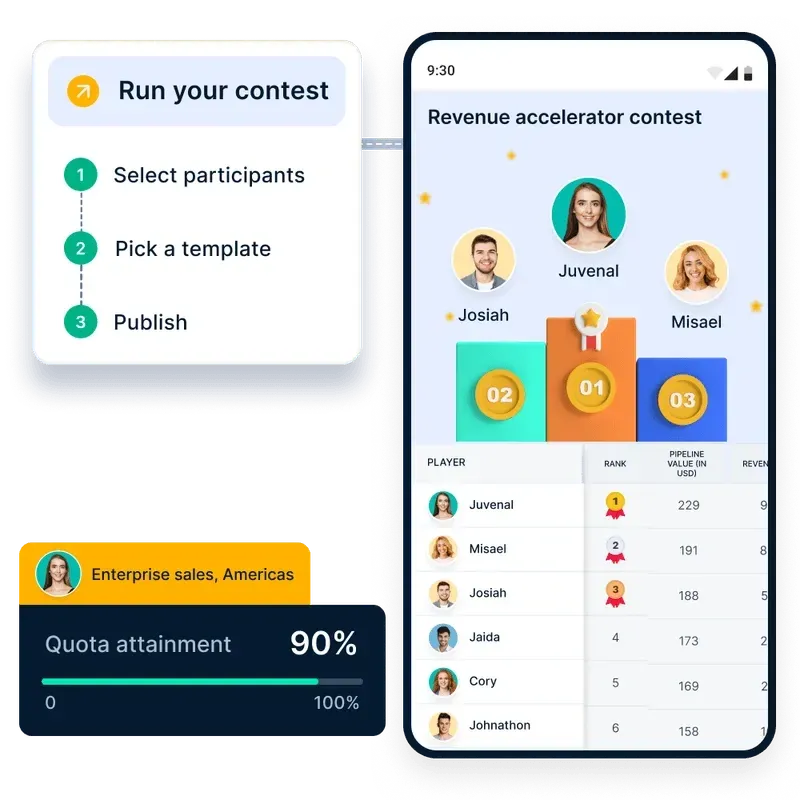
أتمتة دفع العمولات ومواءمة المكافآت مع أهداف المبيعات. باستخدام Compass يمكنك تحفيز فريقك وتحسين فعالية المبيعات بشكل عام. أتمتة الحوافز الآن
أنواع برامج حوافز المبيعات
فيما يلي أنواع مختلفة من برامج حوافز المبيعات.
1. برامج الحوافز القائمة على الفوج
في برامج الحوافز الأساسية للفوج ، يتم تصنيف المستخدمين على أساس عدة مجموعات مثل أصحاب الأداء الأفضل والأداء المتوسط والمؤدين الذيل.
عادة ما يكون 5-10٪ من المستخدمين من أصحاب الأداء الأفضل ، و 25-30٪ من ذوي الأداء المتوسط ، والباقي 60-70٪ من أصحاب الأداء النهائي. من المهم النظر إلى هؤلاء المستخدمين بشكل مختلف لأنهم يأتون بعقليات وكوادر وأساليب مختلفة.
إعداد برنامج حوافز قائم على الفوج:
- الخطوة 1: الخطوة الأولى هي تعيين مجموعات الأداء لمؤسستك / فريقك. حدد وصنف أعلى 10٪ و 30٪ الوسطى وآخر 60٪ من أعضاء فريقك. تأهيل كل عضو في واحدة من هذه الفئات.
- الخطوة 2: الهدف من البرنامج التحفيزي القائم على المجموعة برنامج الحوافز هو تحفيز ورفع متوسط أداء المجموعة. للقيام بذلك، تحتاج إلى تحديد متوسط وأقصى أداء للفوج. إذا كان البرنامج بحاجة إلى أن يكون له تأثير في العمل، فيجب أن يرفع الأداء إلى أعلى من متوسط أداء المجموعة.
- الخطوة 3: استمر في إنشاء معالم بين متوسط المجموعة و 105٪ إلى 120٪ من الحد الأقصى للمجموعة (لتحفيز أفضل أداء في المجموعة مع البرنامج).
- الخطوة 4: يفضل تقديم حوافز إضافية أو حتى ثابتة لكل معلم.
الفوج: أفضل 10%
اسم الفوج: سوبر ستارز
متوسط إيرادات الربع الأخير: $ 10000
الحد الأقصى لإيرادات الربع الأخير: $ 12000
نوع المكافأة وقيمتها: حافز ثابت بنسبة 2.5% من الإيرادات. زيادة طفيفة للشريحة الأخيرة.
هيكل الحوافز
الشريحة 1: تحقيق إيرادات من 10000$ إلى 10500$، احصل على 250$ مكافآت
البلاطة 2: تحقيق إيرادات من 1501$ إلى 11000$، احصل على 262$ مكافآت
البلاطة 3: تحقيق إيرادات من 100001$ إلى 11500$، احصل على 275$ مكافآت
البلاطة 4: تحقيق إيرادات من 11501$ إلى 12000$، احصل على 287$ مكافآت
البلاطة 5: تحقيق إيرادات من 12001 دولار إلى 12500 دولار، احصل على 300 دولار مكافآت
البلاطة 6: تحقيق إيرادات تزيد عن 12500 دولار، احصل على مكافآت بقيمة 320 دولارًا
وبالمثل، يمكن إعداد الألواح لبقية المجموعات بالحفاظ على قيمة المكافأة ضمن الحدود المسموح بها للأعمال.
2. برامج الحوافز الخاصة بأدوار محددة
تتألف فرق المبيعات من أفراد ذوي مسؤوليات مختلفة، وقد لا يكون برنامج الحوافز الذي يناسب الجميع فعالاً. تضمن برامج الحوافز المحددة الأدوار مكافأة مندوبي المبيعات ومديري الحسابات ومندوبي تطوير الأعمال على أساس مساهماتهم الفريدة.
إعداد برنامج حوافز خاص بالأدوار المحددة:
- الخطوة 1: حدد أدوار المبيعات المختلفة داخل فريقك وحدد أهدافها الرئيسية.
- الخطوة 2: ضع معايير أداء تتماشى مع مساهمة كل دور في عملية المبيعات. على سبيل المثال، يمكن تحفيز مندوبي تطوير المبيعات (SDRs) لحجز الاجتماعات المؤهلة، بينما يمكن مكافأة مديري الحسابات التنفيذيين (AEs) لإتمام الصفقات.
- الخطوة 3: هيكلة المكافآت بناءً على مدى تعقيد المهمة. على سبيل المثال، يمكن أن يتلقى مقررو التنمية المستدامة مكافأة ثابتة عن كل اجتماع مقرر، بينما يحصل الوكلاء المساعدون على حوافز قائمة على العمولة لتجاوز الحصص.
- الخطوة 4: مراجعة بيانات الأداء باستمرار لضمان أن يظل هيكل الحوافز ملائمًا وفعالاً.
الهدف النهائي: زيادة اجتماعات المبيعات المؤهلة.
اسم البرنامج: معزز أداء SDR
مؤشرات الأداء الرئيسية: عدد الاجتماعات المحجوزة، عدد العملاء المحتملين المؤهلين للمبيعات.
نوع المكافأة وقيمتها: حافز ثابت لكل اجتماع مكتمل، مع مكافآت إضافية لتجاوز الأهداف.
هيكل الحوافز:
اللوح 1: جدولة 5-7 اجتماعات ← مكافأة 50 دولارًا
الشريحة 2: جدولة 8-10 اجتماعات → مكافأة 75 دولارًا
الشريحة 3: جدولة أكثر من 11 اجتماعاً → 100 دولار مكافأة
3. برامج حوافز المبيعات المجزأة
غالبًا ما تتضمن صفقات المبيعات العديد من أعضاء الفريق، بدءًا من توليد العملاء المحتملين وحتى الإغلاق. يضمن برنامج حوافز المبيعات المقسمة مكافأة جميع المساهمين بشكل عادل، مما يعزز العمل الجماعي والتعاون بدلاً من المنافسة الفردية.
إعداد برنامج حوافز المبيعات المقسّم
- الخطوة 1: حدّد الأدوار التي تساهم في إتمام الصفقة، مثل مندوبي المبيعات ومسؤولي الحسابات التنفيذيين ومهندسي المبيعات.
- الخطوة 2: تحديد مستويات المساهمة لكل دور لتحديد كيفية توزيع الحوافز.
- الخطوة 3: قم بتعيين تقسيمات الحوافز على أساس النسبة المئوية أو الثابتة لضمان دفعات عادلة. على سبيل المثال، يمكن أن يحصل مسؤول المبيعات الذي قام بتوليد العميل المحتمل على 10% من العمولة، بينما يحصل مسؤول المبيعات الذي يقوم بإتمام الصفقة على 70%، ومهندس المبيعات الذي يساعد في المناقشات الفنية على 20%.
- الخطوة 4: أتمتة التتبع وتوزيع المكافآت لتجنب النزاعات وضمان الشفافية.
الهدف النهائي: تشجيع العمل الجماعي في إتمام الصفقات.
اسم البرنامج: مكافأة نجاح الفريق
مؤشرات الأداء الرئيسية: الصفقات المغلقة، نسبة المساهمة لكل دور.
نوع المكافأة وقيمتها: النسبة المئوية للعمولة المقسمة بين المساهمين.
هيكل الحوافز:
SDR (توليد العملاء المحتملين): 10% من العمولة لكل صفقة
مسؤول الحساب التنفيذي (إبرام الصفقات): 70% من العمولة لكل صفقة
مهندس مبيعات (الدعم الفني): 20% من العمولة لكل صفقة
4. برامج الحوافز المرتبطة بمؤشرات الأداء الرئيسية ومؤشرات الأداء الرئيسية الجزئية
عادة ما يتم تقديم الحوافز بناء على ناتج المبيعات النهائي. ومع ذلك ، للتأثير على المخرجات الوسيطة النهائية ، يجب تحفيزها أيضا.
على سبيل المثال ، تؤدي العروض التوضيحية إلى فرص وتؤدي الفرص إلى المبيعات. فيما يلي المزيد من العروض التوضيحية التي يقدمها البائع ، والمزيد من الفرص التي سيولدها ، والمزيد من عمليات الإغلاق التي ستحدث. ومن ثم فإن التحفيز الجزئي للأشخاص بناء على العروض التوضيحية والفرص يؤثر على سلوك المبيعات.
إعداد برنامج حوافز قائم على مؤشرات الأداء الرئيسية:
- الخطوة 1: تتمثل الخطوة الأولى في تحديد مؤشرات الأداء الرئيسية ذات الصلة بأعضاء الفريق المستهدف
- الخطوة 2: الهدف من برنامج الحوافز القائم على مؤشرات الأداء الرئيسية هو دفع أعضاء الفريق إلى إكمال مؤشرات الأداء الرئيسية الدقيقة التي تساعد على تحقيق الهدف النهائي. وللقيام بذلك، تحتاج إلى تحديد المتوسط والحد الأقصى لكل مؤشر من مؤشرات الأداء الرئيسية الجزئية للفريق خلال الربع/الفترة الماضية. يجب أن يكون هدفك الإجمالي لمؤشر الأداء الرئيسي بين هذا المتوسط والحد الأقصى للإنجاز. من الناحية المثالية، يجب أن يكون هذا عند علامة 2 σ إذا كان أداء فريقك السابق على كل مؤشر من مؤشرات الأداء الرئيسية الدقيقة مرسوماً على منحنى طبيعي.
- الخطوة 3: استمر في إنشاء معالم متسلسلة لكل Micro-KPI
- الخطوة 4: تقديم حوافز إضافية أو ثابتة لكل معلم.
الهدف النهائي: إغلاق المبيعات
اسم البرنامج: الإغلاقات الفائقة
مؤشرات الأداء الرئيسية الدقيقة: عدد العروض التجريبية، عدد وثائق نطاق المشروع المنجزة، عدد اتفاقيات البيع الموقعة، عدد المبيعات التي تم إغلاقها
نوع المكافأة وقيمتها: الحافز المتغير والتزايدي
5. برامج الحوافز القائمة على الشارات
من المهم تقدير أساس المستخدمين لإنجازاتهم وسلوكياتهم بمكافآت غير مالية. يمكن استخدام الشارات والشهادات لتحفيز الأشخاص - خاصة لتضمين الأداء وتحفيزه في نهاية بداية الإنجاز المستهدف.
إعداد برنامج حوافز قائم على الشارة:
- الخطوة 1: الخطوة الأولى هي تحديد الشارات بناء على معالم البرنامج
- الخطوة 2: الهدف من برنامج الحوافز القائم على الشارات / الشهادات هو دفع أعضاء الفريق لإكمال المسافة بين بداية الشهر وأول معلم مكافأة.
- الخطوة 3: استمر في إنشاء معالم لكل خطوة يتم تحديدها.
- الخطوة 4: إعداد شارات وتقديمها لكل حدث رئيسي يتم تحديده
الهدف النهائي: دفع المستخدمين حتى 80% من الإنجاز المستهدف
اسم البرنامج: شارة الاندفاع
المعالم: 20% من تحقيق الهدف، 40% من تحقيق الهدف، 60% من تحقيق الهدف، 80% من تحقيق الهدف
هيكل المكافآت
اللوح 1: تحقيق 20% من إنجاز الهدف الفوز بشارة "البداية السريعة
اللوح 2: تحقيق 40٪ من الإنجاز المستهدف الفوز بشارة "محطم الإنجاز
اللوح 3: تحقيق 60% من الإنجاز المستهدف والفوز بشارة "محطم المعالم" البلاطة 4: تحقيق 80% من الإنجاز المستهدف والفوز بشارة "حارس الشارة
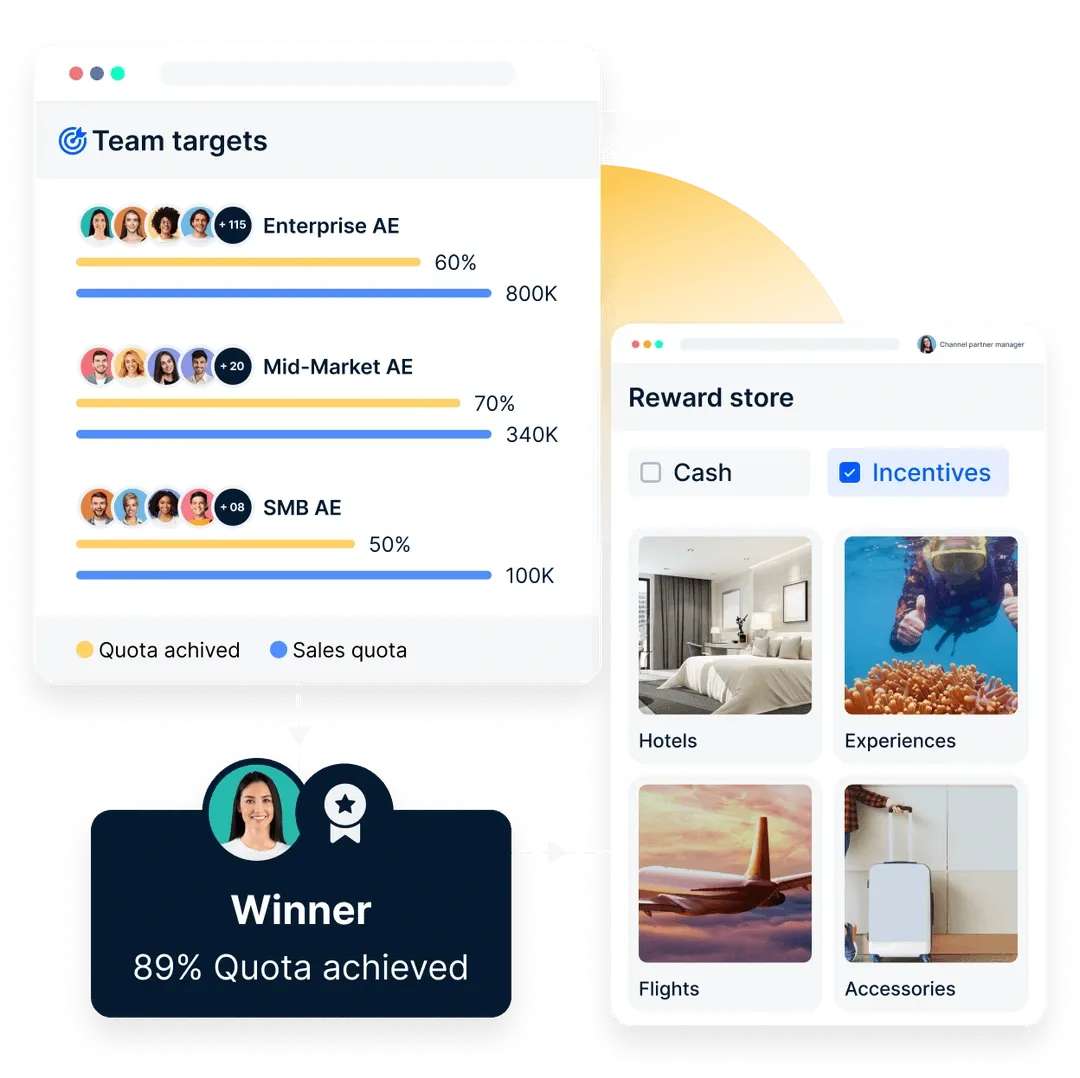
تحويل أداء المبيعات إلى لعبة لزيادة المشاركة
حوّل أهداف المبيعات إلى تحديات مثيرة مع لوحات المتصدرين والمكافآت والتتبع في الوقت الفعلي. تجعل Compass إدارة الأداء جذابة وتنافسية.
ابدأ بتحويل المبيعات إلى ألعاب
6. برنامج الحوافز القائم على التسلسل الهرمي
عادة ما يكون للمبيعات فريق مبيعات إقليمي يقدم تقاريره إلى رئيس المنطقة ثم الرأس الجغرافي ثم الرأس الوطني. من المهم طرح برامج الحوافز عبر جميع مستويات التسلسل الهرمي. هذا يبقي كل مستوى من المستويات متحمسا في جميع الأوقات.
يمكن أن يكون البرنامج النموذجي المستند إلى التسلسل الهرمي إما برنامجا يستند إلى مؤشرات الأداء الرئيسية أو إلى مجموعة يتم تعيينه لكل تسلسل هرمي على حدة - مع أهدافه الخاصة.
7. برامج الحوافز القائمة على السلوك
تواجه الأنواع المختلفة من فرق المبيعات حواجز سلوكية مختلفة. قد يواجه البعض التعب من أجل التحسين ، أو أن بعض نسب المبيعات لا تتحسن (مثل العرض التوضيحي: الإغلاق ، المبيعات المتقاطعة ، عمليات البيع ، إلخ). يمكن تكوين برامج الحوافز لتحسين هذه النسب.
إعداد برنامج حوافز قائم على السلوك:
- الخطوة 1: الخطوة الأولى هي تحديد السلوكيات / نسب الأعمال التي تنتج عن هذه السلوكيات
- الخطوة 2: الهدف من برنامج الحوافز القائم على السلوك هو دفع أعضاء الفريق لاختراق نسب أدائهم الراكدة. على غرار برامج مؤشرات الأداء الرئيسية الصغيرة ، حدد نطاقا من القيم بين 2 سيجما و 3 سيجما لكل من هذه النسب في فريقك.
- الخطوة 3: استمر في إنشاء المعالم التي تتحقق من تحقيق كل من حدود النسبة المحددة هذه.
- الخطوة 4: تقديم مكافآت ثابتة / إضافية لكل معلم
الهدف النهائي: دفع المستخدمين إلى المشاركة في البيع المتبادل والبيع المتقاطع والبيع الإضافي
اسم البرنامج: المبيعات الشاملة
8. برامج الحوافز القائمة على إدارة العلاقة مع العملاء
لقد كانت حقيقة أن 70٪ CRMs تفشل في إقناع فرق المبيعات باعتمادها الكامل. فرق المبيعات مترددة في تغيير واستخدام CRM.
إن التواصل مع الاعتماد بنسبة 100٪ على الحوافز على موجز CRM لفريق المبيعات وإنشاء برنامج حوافز يسحب البيانات من CRM فقط يزيد من استخدامه / اعتماده بشكل جذري.
9. برامج الحوافز الموسمية أو القائمة على الوقت
قد يكون لدى الشركات موسمية خلال الشهر أو خلال العام. لتوزيع أحجام الأعمال بالتساوي - يتم إطلاق برامج الحوافز القائمة على الوقت.
كما يتم طرح برامج الحوافز الموسمية خلال موسم ارتفاع الأعمال. هذا يجعل المستخدمين يبذلون جهدا إضافيا عندما يكون السوق هو الأكثر احتمالا.
10. برامج تحسين الأداء (PIP)
هناك مستخدمون إما غير أكفاء أو غير مستعدين للتسليم / البيع. من المهم تحريك هؤلاء المستخدمين بموضوعية. يتم تكوين برامج PIP (أو خطط ال 30 يوما التالية) استنادا إلى الأداء السابق للمستخدمين. يعتبر الناتج للاحتفاظ.
إعداد برنامج حوافز PIP:
- الخطوة 1: تتمثل الخطوة الأولى في تحديد مؤشرات الأداء الرئيسية التي يحتاج المستخدم إلى إكمالها في أيام 30 القادمة للسماح بالاحتفاظ بها.
- الخطوة 2: الهدف من برنامج PIP هو مساعدة أعضاء فريق البيع بالتجزئة وتطويرهم ليصبحوا أفضل أداءً. تحتاج إلى تحديد الحد الأدنى لأداء مؤشرات الأداء الرئيسية لبقية أعضاء الفريق خلال الفترة الماضية. يجب تحديد هدف مؤشرات الأداء الرئيسية لبرنامج PIP كحد أدنى للأداء. قسّم هذه الأهداف إلى 4 أهداف وسيطة (عادةً هدف لكل أسبوع)
- الخطوة 3: استمر في إنشاء معالم لكل مجموعة من مؤشرات الأداء الرئيسية PIP
- الخطوة 4: قدم شارات في كل مرحلة رئيسية وإذا كانت الميزانية تسمح بمكافأة.
الهدف النهائي: تحسين الأداء
اسم البرنامج: النجم الصاعد
مؤشرات الأداء الرئيسية للبرنامج: إكمال وحدة نظام إدارة التعلم عن بُعد، تحقيق هدف برنامج PIP
11. برامج الحوافز الجماعية
من أجل تحقيق الشعور بالعمل الجماعي كفريق - يتم إطلاق برامج الحوافز القائمة على الفريق. عادة ما تكون برامج الحوافز هذه جغرافية أو إدارية.
يمكن أن يكون البرنامج النموذجي القائم على الفريق برنامجا قائما على مؤشرات الأداء الرئيسية مع تقسيم أهداف الفريق الإجمالية إلى معالم.
12. برامج حوافز التغلب على البطل
لإعطاء دفعة كبيرة للمستخدمين - تم إطلاق Beat-The-Champion للشهر / الربع / العام الماضي. يؤثر هذا على المستخدمين (خاصة أصحاب الأداء المتوسط والأدنى) للحصول على دفعة ذاتية لتحقيق المزيد والتغلب على البطل.
إعداد برنامج تحفيزي للتغلب على البطل:
- الخطوة 1: الخطوة الأولى هي تحديد قائمة الأبطال (أول 4 حاملي مراتب ) ورتب كل منهم
- الخطوة 2: الهدف من برنامج Beat-The-Champion هو مساعدة المستخدمين على التغلب على الإنجازات المستهدفة لهؤلاء الأبطال.
- الخطوة 3: استمر في إنشاء معالم للإنجازات المستهدفة لكل من حاملي الرتب.
- الخطوة 4: قدم مكافآت في كل معلم.
الهدف النهائي: تحسين الأداء
اسم البرنامج: التغلب على البطل
13. برامج الحوافز المخصصة لتحديد الأهداف الشخصية
لا يتم تحفيز جميع مندوبي المبيعات بنفس الأهداف. فبرنامج الحوافز المخصص لتحديد الأهداف يسمح للأفراد باختيار أهدافهم ومكافآتهم، مما يزيد من الحافز والالتزام بتحقيق النتائج.
إعداد برنامج تحفيزي مخصص لتحديد الأهداف:
- الخطوة 1: اسمح لمندوبي المبيعات بتحديد أهداف المبيعات الخاصة بهم من مجموعة خيارات محددة مسبقاً. يمكن أن يشمل ذلك أهداف الإيرادات، أو حجم الصفقات، أو اكتساب العملاء، أو النسب المئوية لزيادة المبيعات.
- الخطوة 2: قم بتعيين هياكل مكافآت متفاوتة بناءً على صعوبة الهدف. يجب أن تأتي الأهداف ذات المخاطر الأعلى مع تحديات أكبر بمكافآت أعلى.
- الخطوة 3: توفير تتبع مستمر للأداء، مما يسمح للمندوبين بتعديل أهدافهم في منتصف الدورة إذا لزم الأمر.
- الخطوة 4: احتفل بالإنجازات الفردية من خلال التقدير العام والشارات وتصنيفات لوحة المتصدرين لتشجيع المنافسة الصحية.
الهدف النهائي: منح مندوبي المبيعات ملكية أهدافهم.
اسم البرنامج: اختر التحدي الخاص بك
مؤشرات الأداء الرئيسية: أهداف المبيعات الفردية (حصة المبيعات الفردية، أو حجم الصفقات، أو الاحتفاظ بالعملاء، أو زيادة المبيعات).
نوع المكافأة وقيمتها: حوافز مخصصة بناءً على صعوبة الهدف.
هيكل الحوافز:
الهدف 1: إغلاق 5 صفقات جديدة ← مكافأة 500 دولار
الهدف 2: إغلاق 3 صفقات مؤسسية → مكافأة 800 دولار
الهدف 3: زيادة إيرادات زيادة المبيعات بنسبة 20٪ → مكافأة 1,000 دولار أمريكي
14. برامج المكافآت التجريبية
الحوافز النقدية ليست الطريقة الوحيدة لتحفيز الموظفين. تركّز برامج المكافآت التجريبية على تقديم تجارب فريدة لا تُنسى - مثل السفر أو فعاليات كبار الشخصيات أو الوصول الحصري - لإلهام أعلى مستويات الأداء. تخلق هذه المكافآت قيمة دائمة تتجاوز الحوافز النقدية.
إعداد برنامج المكافآت التجريبي:
- الخطوة 1: حدد المكافآت القائمة على التجربة التي تلقى صدى لدى فريق المبيعات لديك، مثل السفر الفاخر أو تذاكر الحفلات الموسيقية أو فعاليات التواصل الحصرية.
- الخطوة 2: ضع أهدافاً للأداء تتماشى مع هذه المكافآت عالية القيمة، مما يضمن حصول أصحاب الأداء المتميز على تجارب تتناسب مع جهودهم ونتائجهم.
- الخطوة 3: قم بإنشاء مستويات إنجاز متدرجة حيث يمكن لمندوبي المبيعات فتح تجارب أفضل كلما تجاوزوا مراحل الإنجاز.
- الخطوة 4: تكريم الفائزين علناً ومشاركة قصص نجاحهم لإلهام الآخرين.
الهدف النهائي: مكافأة أصحاب الأداء المتميز بتجارب حصرية.
اسم البرنامج: نادي النخبة المنجزين
مؤشرات الأداء الرئيسية: نمو الإيرادات، وحجم الصفقات، والإنجاز الزائد للحصص.
نوع المكافأة وقيمتها: المكافآت القائمة على الخبرة بدلاً من المكافآت النقدية.
هيكل الحوافز:
الشريحة 1: تحقيق 100-110% من الحصة ← عشاء فاخر مدفوع التكاليف بالكامل
الشريحة 2: تحقيق 111-120% من الحصة → عطلة نهاية الأسبوع في منتجع فاخر
الشريحة 3: تحقيق 121% فأكثر من الحصة ← عطلة دولية أو دخول فعالية لكبار الشخصيات
كيفية إنشاء برنامج حوافز المبيعات
يقوم برنامج حوافز المبيعات المصمم جيدًا بأكثر من مجرد مكافأة الأداء - فهو يحفز السلوك، ويوائم جهود المبيعات مع أهداف العمل، ويعزز المشاركة طويلة الأجل. إليك كيفية إنشاء برنامج منظم وفعال لحوافز المبيعات باستخدام Compass.
1. تحديد أهداف واضحة
يحتاج برنامج حوافز المبيعات إلى أساس قوي، يبدأ بأهداف محددة بوضوح. هل تتطلع إلى زيادة إبرام الصفقات، أو تقصير دورات المبيعات، أو دفع التوسع في أسواق جديدة؟ بدون اتجاه واضح، قد تفشل حتى أكثر الحوافز جاذبية في تحقيق النتائج.
يضمن لك Compass توافق برنامج الحوافز الخاص بك مع أولويات العمل الأوسع نطاقاً من خلال توفير رؤى قائمة على الذكاء الاصطناعي حول أداء المبيعات. فهو يتتبع المساهمات الفردية والجماعية، مما يساعدك على قياس التقدم المحرز مقابل الأهداف في الوقت الفعلي. من خلال رؤية المقاييس الرئيسية، يمكنك تحسين الاستراتيجيات وتعديل المكافآت بناءً على نتائج المبيعات الفعلية.
2. تحديد مؤشرات الأداء الرئيسية (KPIs)
يعتمد نجاح برنامج حوافز المبيعات على اختيار مقاييس الأداء الصحيحة. فمؤشرات الأداء الرئيسية الواضحة والقابلة للقياس تضمن فهم مندوبي المبيعات لما يحتاجون إلى تحقيقه وكيفية مساهمة جهودهم في نمو الأعمال بشكل عام.
تتضمن مؤشرات الأداء الرئيسية الشائعة لبرامج حوافز المبيعات ما يلي:
- إجمالي الإيرادات المحققة: يشجع على نمو المبيعات الإجمالية.
- اكتساب عملاء جدد: دفع الجهود نحو توسيع قاعدة العملاء.
- حجم الصفقة وقيمتها: تحفز المبيعات عالية القيمة بدلاً من مجرد الحجم.
- معدلات البيع الإضافي والبيع العابر: تحفيز المندوبين على تحقيق أقصى قدر من الإيرادات لكل عميل.
- طول دورة المبيعات: يكافئ الكفاءة في إتمام الصفقات بشكل أسرع.
- الاحتفاظ بالعملاء وتجديد عقودهم: يشجع على بناء علاقات طويلة الأمد.
- معدلات تحويل العملاء المحتملين: يركز على تحسين كفاءة خط أنابيب المبيعات.
تعمل Compass على أتمتة تتبع مؤشرات الأداء الرئيسية من خلال التحليلات والتقارير في الوقت الفعلي. يحصل مندوبو المبيعات على ملاحظات فورية حول أدائهم، بينما يحصل المديرون على رؤى قابلة للتنفيذ لضبط الاستراتيجيات. تساعد التوصيات المستندة إلى الذكاء الاصطناعي في تحديد مؤشرات الأداء الرئيسية التي تحقق أكبر قدر من التأثير، مما يسمح بالتحسين المستمر للبرنامج.
3. تصميم هيكل الحوافز
إن برنامج الحوافز الفعال يتجاوز مجرد تقديم المكافآت، بل يجب أن يكون منظمًا لتحفيز السلوكيات الصحيحة مع الحفاظ على تفاعل فرق المبيعات. ويكمن السر في تحقيق التوازن بين الحوافز النقدية وغير النقدية لجذب الدوافع المختلفة.
أنواع حوافز المبيعات التي يجب مراعاتها:
- المكافآت النقدية: العمولات أو المكافآت أو المكافآت أو تقاسم الأرباح أو الحوافز المتدرجة بناءً على الأداء.
- المكافآت غير النقدية: برامج التقدير، وفرص التقدم الوظيفي، وتجارب كبار الشخصيات.
- صناديق حوافز أداء المبيعات (SPIFs): المكافآت قصيرة الأجل لتعزيز الأداء في مجالات محددة، مثل إتمام الصفقات بشكل أسرع أو بيع منتجات ذات هامش ربح مرتفع.
- الحوافز القائمة على الفريق: تشجع على التعاون من خلال مكافأة المجموعات على تحقيق الأهداف المشتركة.
- المكافآت المستندة إلى المعالم: تعترف بالأداء المتسق على مدار الوقت بدلاً من مجرد إنجازات لمرة واحدة.
تتيح Compass للشركات تخصيص هياكل الحوافز الخاصة بها بناءً على بيانات المبيعات في الوقت الفعلي. مع حسابات العمولة الآليةوميزات تحديد الأهداف الديناميكية وميزات التحفيز، تحافظ Compass على تحفيز مندوبي المبيعات مع ضمان العدالة والشفافية في المدفوعات. كما تتيح المنصة أيضاً إمكانية اختبار A/B لهياكل الحوافز المختلفة، حتى تتمكن من تحسين نهجك بناءً على ما يحقق أفضل النتائج.
4. التواصل مع البرنامج بفعالية
حتى أفضل برامج حوافز المبيعات المصممة بشكل جيد يمكن أن تفشل إذا لم يتم توصيلها بوضوح. يحتاج مندوبو المبيعات إلى فهم كيفية عمل البرنامج، وما يتعين عليهم القيام به لكسب المكافآت، وكيف سيتم تتبع أدائهم. يمكن أن يؤدي الارتباك أو انعدام الشفافية إلى فك الارتباط، مما يقلل من فعالية البرنامج.
العناصر الرئيسية للتواصل الفعال:
- وضوح الأهداف والمكافآت -حدد بوضوح ما هي السلوكيات والإنجازات التي ستتم مكافأتها.
- قنوات اتصال متعددة: استخدم رسائل البريد الإلكتروني واجتماعات الفريق ولوحات المعلومات والجلسات الفردية لضمان إطلاع الجميع على المستجدات.
- رؤية في الوقت الفعلي: اسمح للممثلين بتتبع أرباحهم، والتقدم نحو تحقيق الأهداف، وترتيب المتصدرين في أي وقت.
- تحديثات وتذكيرات منتظمة: تعزيز المشاركة من خلال تحديثات دورية حول ترتيب الأداء والفرص القادمة.
يبسّط Compass الاتصال بالبرنامج من خلال لوحة تحكم مركزية حيث يمكن لفرق المبيعات تتبع تقدمهم في الوقت الفعلي. تحافظ الإشعارات المخصصة والتحفيزات التي تعتمد على الذكاء الاصطناعي على مشاركة المندوبين وتركيزهم على تحقيق أهدافهم. كما تضمن لوحات المتصدرين وتحديثات الأداء التلقائية معرفة الجميع بموقفهم، مما يؤدي إلى زيادة المنافسة الودية وارتفاع معدلات المشاركة.
5. تنفيذ البرنامج بالأدوات المناسبة
يحتاج برنامج حوافز المبيعات المصمم جيدًا إلى تنفيذ سلس. فمجرد الإعلان عن الحوافز ليس كافياً - يجب أن يكون لدى مندوبي المبيعات الأدوات والموارد اللازمة لتقديم أفضل أداء لهم. يجب أن تركز مرحلة التنفيذ على تزويد الفريق بكل ما يحتاجونه لتحقيق النجاح، بدءاً من المواد التدريبية إلى الدعم المستمر.
الخطوات الرئيسية للتنفيذ السلس:
- توفير إمكانية الوصول إلى موارد التدريب والمبيعات: تأكد من حصول مندوبي المبيعات على ضمانات محدثة وعروض تقديم العروض الترويجية والمعرفة بالمنتج لإتمام الصفقات بفعالية.
- التكامل مع عمليات المبيعات: يجب أن يتماشى برنامج الحوافز مع تدفقات العمل الحالية، مما يسهل على المندوبين المشاركة دون تعطيل أنشطتهم اليومية.
- تقديم الدعم في الوقت الفعلي: تزويد المديرين برؤى حول أداء المبيعات حتى يتمكنوا من تدريب المندوبين ومعالجة التحديات عند ظهورها.
- ضمان التتبع الفوري للأداء: يجب أن يكون لدى مندوبي المبيعات رؤية فورية لإنجازاتهم ومكافآتهم المعلقة وأهدافهم.
تعمل Compass على تبسيط التنفيذ من خلال دمج برامج الحوافز مباشرةً في سير عمل المبيعات. من خلال التتبع في الوقت الفعلي، وحسابات العمولة الآلية، والتدريب المدعوم بالذكاء الاصطناعي، تحافظ فرق المبيعات على تركيزها وتحفيزها. تتيح لوحات المعلومات المخصصة للممثلين رؤية تقدمهم والوصول إلى الموارد وتلقي التنبيهات في الوقت المناسب لمساعدتهم على البقاء على المسار الصحيح.
6. مراقبة البرنامج وضبطه
إن برنامج حوافز المبيعات ليس مبادرة "اضبطها وانسها". فالمراقبة المنتظمة ضرورية لضمان استمرار البرنامج في تحفيز السلوكيات الصحيحة والتكيف مع احتياجات العمل المتطورة. فبدون التحليل المستمر، يمكن أن تصبح هياكل الحوافز قديمة، مما يؤدي إلى فك الارتباط أو العواقب غير المقصودة.
الجوانب الرئيسية للمراقبة الفعالة للبرامج:
- تتبع اتجاهات الأداء: تحديد الحوافز التي تحقق أعلى تأثير وأين يلزم إجراء تعديلات.
- جمع ملاحظات مندوبي المبيعات: احصل على رؤى من المشاركين لفهم ما ينجح وما يحتاج إلى تحسين.
- تحليل عائد استثمار الحوافز: قارن الاستثمار في المكافآت مع نمو الإيرادات وحجم الصفقات وإنتاجية المبيعات الإجمالية.
- تعديل هياكل الحوافز عند الضرورة: قم بتعديل الأهداف، أو هياكل الدفع، أو أنواع المكافآت للحفاظ على ملاءمة البرنامج وفعاليته.
تعمل Compass على تبسيط مراقبة البرنامج من خلال التحليلات المدعومة بالذكاء الاصطناعي التي توفر رؤى في الوقت الفعلي حول أداء المبيعات. تحدد المنصة تلقائياً الاتجاهات وتحدد المجالات ذات الأداء الضعيف وتوصي بالتحسينات لزيادة فعالية الحوافز إلى أقصى حد. باستخدام Compass يمكنك تحسين برنامجك باستمرار لضمان المشاركة طويلة الأجل ونمو الأعمال.
7. قياس نجاح البرنامج
لتحديد ما إذا كان برنامج حوافز المبيعات الخاص بك يحقق الأهداف المرجوة منه، فأنت بحاجة إلى نهج منظم لقياس النجاح. لا يكفي مجرد النظر إلى نمو الإيرادات - فأنت بحاجة إلى تقييم كيفية تأثير الحوافز على سلوك المبيعات ومشاركة الفريق وأداء الأعمال على المدى الطويل.
الطرق الرئيسية لقياس النجاح
- مقارنة بيانات المبيعات قبل التنفيذ وبعده: تقييم التحسينات في المقاييس الرئيسية مثل نمو الإيرادات وحجم الصفقات ومعدلات التحويل.
- تقييم معدلات إنجاز مؤشرات الأداء الرئيسية: تتبع عدد مندوبي المبيعات الذين يحققون أهدافهم أو يتجاوزونها.
- مراقبة الاحتفاظ والمشاركة: يُعد بقاء مندوبي المبيعات ذوي الأداء العالي مع الشركة لفترة أطول مؤشراً قوياً على وجود برنامج حوافز فعال.
- تقييم إنتاجية الفريق: حدد ما إذا كانت دورات المبيعات قد اختصرت وما إذا كان المندوبون يغلقون المزيد من الصفقات بكفاءة أكبر.
- اجمع ملاحظات مباشرة: قم بإجراء استبيانات أو عقد مناقشات مع فريق المبيعات لديك لتحديد نقاط القوة ومجالات التحسين.
توفر Compass تتبعاً وتحليلات متعمقة للأداء لقياس فعالية برنامج الحوافز الخاص بك. تساعدك الرؤى المستندة إلى الذكاء الاصطناعي على فهم الحوافز التي تعمل، والحوافز التي تحتاج إلى تعديلات، وكيفية مساهمة البرنامج في نمو الأعمال بشكل عام. باستخدام Compass يمكن لقادة المبيعات اتخاذ قرارات مدعومة بالبيانات لتحسين استراتيجيتهم وتحسين النتائج باستمرار.
8. التغلب على التحديات المشتركة
حتى أفضل برامج حوافز المبيعات المصممة بشكل جيد يمكن أن تواجه عقبات. فالأهداف غير المتوافقة أو عدم المشاركة أو هياكل المكافآت غير الواضحة يمكن أن تقلل من الفعالية. إن معالجة هذه التحديات في وقت مبكر يضمن أن يظل برنامجك مؤثراً ويؤدي إلى ثبات أداء المبيعات.
التحديات والحلول المشتركة:
- هياكل الحوافز غير الواضحة: إذا لم يفهم مندوبو المبيعات بشكل كامل كيف تتم مكافأتهم، تنخفض المشاركة. توفر Compass لوحات معلومات في الوقت الفعلي تعرض الأرباح والتقدم والأهداف بشفافية.
- انخفاض معدلات المشاركة: قد لا يشعر بعض المندوبين بالحافز من خلال الحوافز التقليدية. تُحافظ ميزات التلعيب في Compass مثل لوحات المتصدرين وشارات الإنجاز والدوافع الشخصية، على مستوى عالٍ من المشاركة.
- عدم القدرة على التكيف: تتغير ظروف السوق، وسرعان ما تصبح برامج الحوافز الثابتة غير فعالة. تستخدم Compass رؤى مدعومة بالذكاء الاصطناعي لاقتراح تعديلات على البرنامج، مما يضمن بقاء الحوافز ملائمة.
تأخر المدفوعات ومشكلات التتبع: قد يؤدي حساب العمولات يدويًا إلى حدوث أخطاء ونزاعات. تعمل Compass على أتمتة عمليات حساب العمولات، مما يحد من التأخير ويضمن دقة وشفافية المدفوعات.
نموذج لهيكل خطة حوافز المبيعات
اسم البرنامج: خطة حوافز أداء المبيعات للربع الثاني
الهدف: زيادة الإيرادات الإجمالية بنسبة 20% وتحسين اكتساب العملاء من خلال جهود المبيعات المستهدفة.
الأهلية: جميع مندوبي المبيعات ومديري الحسابات
المدة الزمنية: 1 أبريل - 30 يونيو
أنواع الحوافز
الحوافز النقدية:
- عمولة 5% على جميع الصفقات المُبرمة
- مكافأة قدرها 1,000 دولار أمريكي لتجاوز أهداف المبيعات ربع السنوية بنسبة 15%
الحوافز غير النقدية:
- جائزة "أفضل أداء في الربع السنوي" مع بطاقة هدايا بقيمة 500 دولار أمريكي
- تدريب حصري على المبيعات وإرشاد حصري لأفضل 3 أشخاص من ذوي الأداء العالي
الحوافز القائمة على الفريق:
- إذا وصل فريق المبيعات بأكمله إلى هدف نمو الإيرادات بنسبة 20%، يحصل كل عضو على باقة عطلة نهاية الأسبوع
مقاييس الأداء والمكافآت
هيكل الدفع
العمولة الثابتة: عمولة بنسبة 5% على جميع المبيعات
العمولة المتدرجة: عمولة 7% للمبيعات التي تتجاوز 75,000 دولار أمريكي في ربع السنة
عتبات المكافأة: 1,000 دولار مكافأة لأكثر من 10 عملاء جدد
التواصل والتتبع
- خطة التواصل: اجتماعات الفريق الأسبوعية ولوحات متابعة الأداء وتحديثات البريد الإلكتروني
- أدوات التتبع: Salesforce CRM، لوحة صدارة المبيعات في الوقت الفعلي
المراجعة والتعديلات
- تواتر التقييم: مراجعات منتصف الربع ونهاية الربع الدراسي
- آلية التغذية الراجعة: استبيانات شهرية لتقييم فعالية البرنامج
صُمم برنامج حوافز المبيعات هذا لتحفيز المبيعات وزيادة الإيرادات ومكافأة أصحاب الأداء العالي مع ضمان النمو المستدام.
عزز حوافز المبيعات الخاصة بك مع Compass
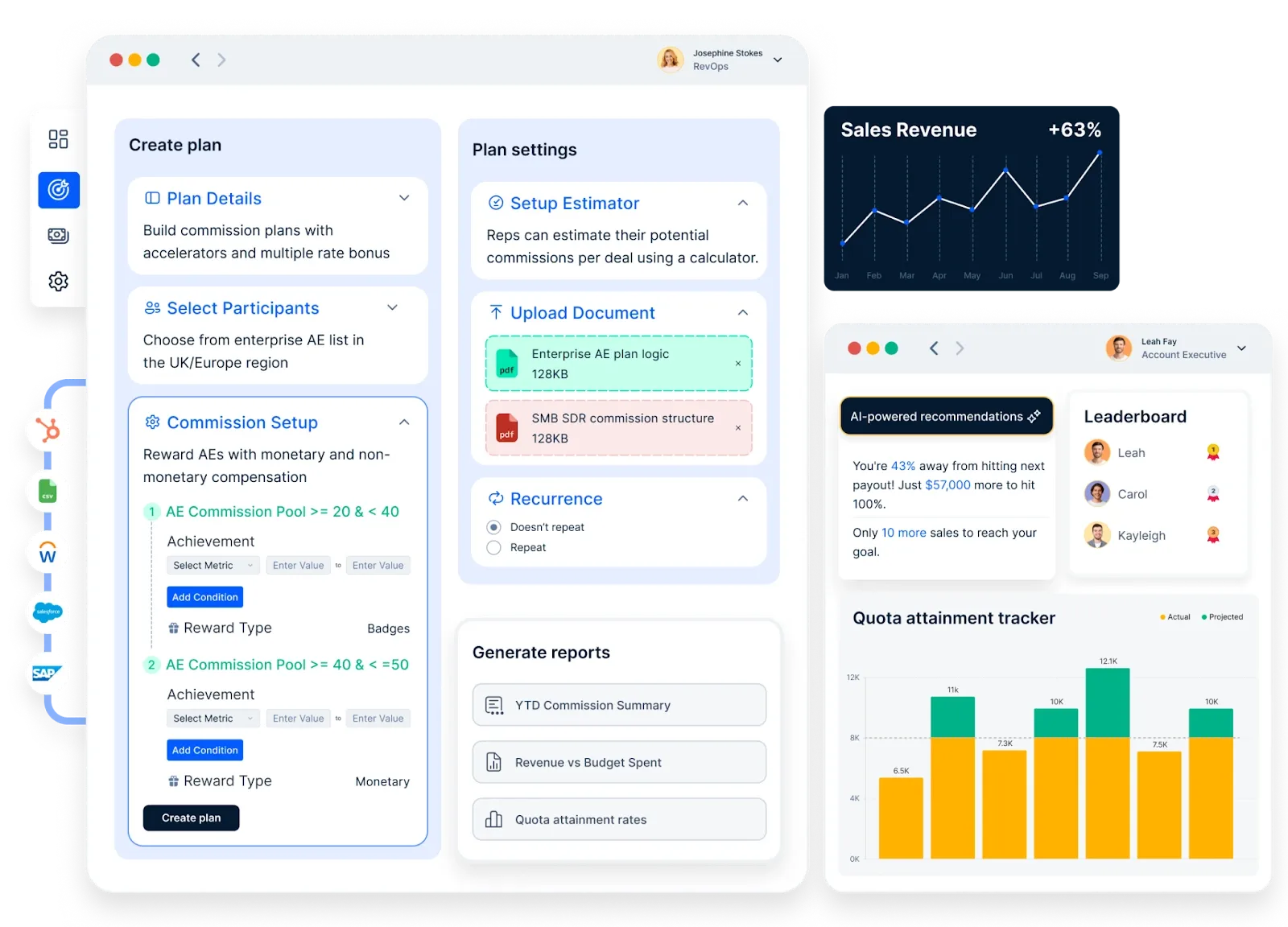
تجعل Compass حوافز المبيعات سلسة من خلال العمولات الآلية، ولوحات المتصدرين في الوقت الفعلي، والرؤى القائمة على الذكاء الاصطناعي. حَفِّز فريقك من خلال المدفوعات الشفافة والتحديات المُحَفِّزة والمكافآت المدعومة بالبيانات التي تحفز الأداء.
قم ببناء برنامج تحفيزي ناجح اليوم!
استنتاج
يمكن أن يكون برنامج حوافز المبيعات المصمم جيدا أداة قوية لزيادة المبيعات وتعزيز مشاركة الموظفين وزيادة الإنتاجية.
باتباع هذه الخطوات الرئيسية ، يمكنك إنشاء برنامج يتوافق مع أهداف عملك ويقود السلوكيات المرغوبة من فريق المبيعات الخاص بك. تذكر مراقبة البرنامج وتعديله باستمرار بناء على البيانات والتعليقات ، والاحتفال بنجاحات فريقك.
الأسئلة الشائعة
فيما يلي بعض الأسئلة المتداولة حول برامج حوافز المبيعات.
ما هي أنواع الحوافز الأكثر فعالية لفرق المبيعات؟
تشمل الحوافز الأكثر فعالية لفرق المبيعات المكافآت المالية مثل المكافآت والعمولات والمكافآت غير النقدية مثل حوافز السفر وبرامج التقدير.
كم مرة يجب إجراء مراجعات الأداء؟
وينبغي إجراء استعراضات الأداء على أساس منتظم، عادة كل ثلاثة أشهر أو سنويا، لتقديم التغذية المرتدة وتقييم التقدم المحرز.
ماذا يحدث إذا لم يحقق أحد أعضاء فريق المبيعات أهدافه؟
إذا لم يحقق أحد أعضاء فريق المبيعات أهدافه ، فمن المهم توفير التدريب والدعم لمساعدته على التحسن. اعتمادا على الموقف ، قد تكون هناك خطط إضافية للتدريب أو تحسين الأداء.
هل يجب إعطاء حوافز لأصحاب الأداء الأفضل فقط أم لجميع أعضاء فريق المبيعات؟
يمكن تقديم حوافز لأصحاب الأداء الأفضل وجميع أعضاء فريق المبيعات ، اعتمادا على أهداف البرنامج. يمكن أن يحفز الفريق بأكمله والتعرف على الإنجازات الفردية.
هل يمكن دمج برنامج حوافز المبيعات مع برامج تقدير الموظفين الأخرى؟
نعم ، يمكن دمج برنامج حوافز المبيعات مع برامج تقدير الموظفين الأخرى لإنشاء نظام مكافآت شامل وشامل يعترف بكل من إنجازات المبيعات والمساهمات الأخرى في المنظمة.

